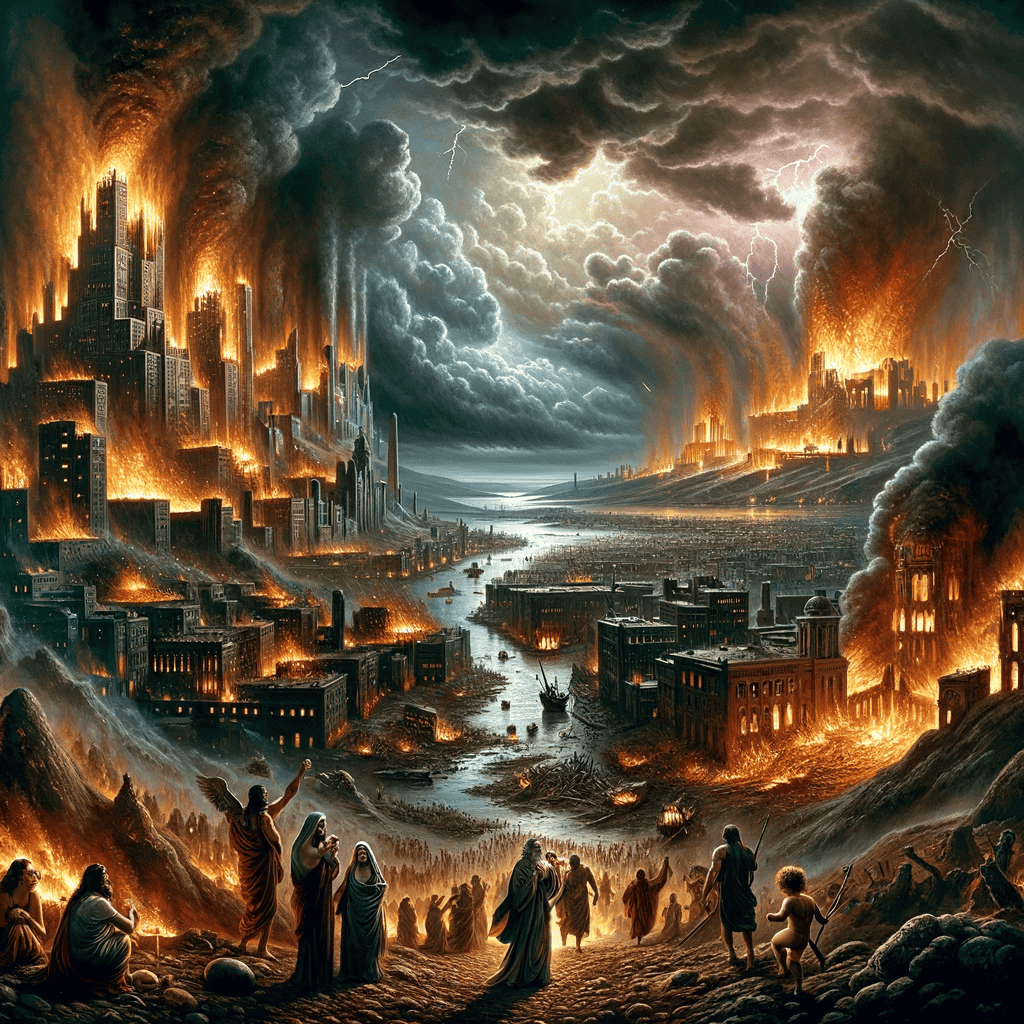
The story of Sodom and Gomorrah is a powerful and sobering narrative found in Genesis 18:16-19:29, illustrating divine judgment against wickedness and the intercession of the righteous. It unfolds as follows:
Abraham’s Intercession (Genesis 18:16-33): After being visited by three men (who were manifestations of the LORD and His angels), Abraham learns of God’s intention to judge the cities of Sodom and Gomorrah for their great sin. Abraham, concerned for the righteous living in these cities, notably his nephew Lot, engages in a remarkable dialogue with the LORD. He intercedes on behalf of the cities, asking if God would spare them if fifty righteous people were found within. Abraham persistently negotiates the number down to ten, with God agreeing each time that He would not destroy the cities if that many righteous individuals were found.
The Angels Visit Lot in Sodom (Genesis 19:1-11): Two angels arrive in Sodom and are welcomed into Lot’s home. The men of the city, demonstrating the wickedness for which the city was condemned, surround Lot’s house and demand that he bring out his guests so they might have their way with them. Lot offers his own daughters in a desperate attempt to protect his guests, but the men refuse and press aggressively against Lot. The angels intervene, pulling Lot back into the house and striking the men with blindness to protect their host.
The Escape from Sodom (Genesis 19:12-22): The angels then inform Lot of the impending destruction and urge him to flee with his family. Lot hesitates, prompting the angels to forcibly lead him, his wife, and his two daughters out of the city, instructing them not to look back as they flee. They urge Lot to escape to the mountains, but Lot pleads to flee to a small nearby town (Zoar) instead. The angels grant this request, showing mercy in the midst of judgment.
The Destruction of Sodom and Gomorrah (Genesis 19:23-29): As Lot reaches Zoar, the LORD rains down sulfur and fire from heaven, utterly destroying Sodom and Gomorrah and all the inhabitants of the cities, as well as the vegetation of the land. Lot’s wife, against the angels’ instruction, looks back and becomes a pillar of salt, a lasting symbol of disobedience and attachment to a sinful past.
Lessons and Themes: This narrative serves multiple purposes in the biblical context. It underscores the gravity of sin and the certainty of divine judgment while also highlighting the power of intercessory prayer and the mercy of God towards the righteous. Abraham’s negotiation with God emphasizes the importance of the righteous within a society and God’s willingness to spare the wicked for the sake of the righteous. The angels’ intervention to save Lot and his daughters illustrates God’s care for those who are His, even when they are found in the midst of wickedness.
The Aftermath and Its Implications (Genesis 19:30-38): Following the destruction of Sodom and Gomorrah, Lot and his daughters, now dwelling in a cave for fear of living in Zoar, face the grim reality of their isolation. Believing themselves to be the last people on Earth, Lot’s daughters make the consequential decision to preserve their family line through their father. This decision results in the birth of Moab and Ben-Ammi, ancestors of the Moabites and Ammonites, nations that would later have significant, often contentious, interactions with the Israelites.
Theological Reflections:
- Divine Justice and Mercy: The destruction of Sodom and Gomorrah is a stark testament to the biblical theme of divine justice, meted out against unrepentant wickedness. Yet, within this narrative of judgment, the elements of divine mercy are evident—not only in the sparing of Lot and his daughters but also in the willingness of God to spare the cities for the sake of a few righteous individuals. This duality of justice and mercy reflects a complex understanding of God’s character in biblical theology.
- Human Agency and Divine Will: Abraham’s intercession highlights the role of human agency in dialogue with the divine. His bold yet respectful negotiation with God showcases the biblical principle that individuals can, and indeed are encouraged to, engage with God on matters of moral and spiritual concern. This interaction also underscores the value of righteousness and its potential to influence divine action.
- Moral Lessons: The account serves as a moral caution against the dangers of societal wickedness and the importance of adhering to divine commands. Lot’s wife turning into a pillar of salt serves as an enduring symbol of the consequences of disobedience and the danger of longing for a sinful past. The narrative also challenges readers to consider the implications of their actions and the importance of living righteously within their communities.
- Legacy and Interpretation: The story of Sodom and Gomorrah has left a lasting legacy, influencing not just religious thought but also cultural and ethical discussions throughout history. Its themes have been revisited in discussions of hospitality, justice, sin, and redemption across various cultural and religious contexts. The narrative has been subject to various interpretations, each focusing on different aspects of the story—from the sinfulness of the cities to the righteousness and failings of Lot and his family.
In conclusion, the story of Sodom and Gomorrah, while rooted in a specific historical and cultural context, speaks to universal themes of divine justice, mercy, human morality, and the complexities of human-divine interaction. It serves as a reminder of the consequences of widespread immorality and the potential for redemption through righteousness. Through the lens of faith, this narrative encourages reflection on the nature of God’s justice and the importance of living in a manner that aligns with divine expectations.